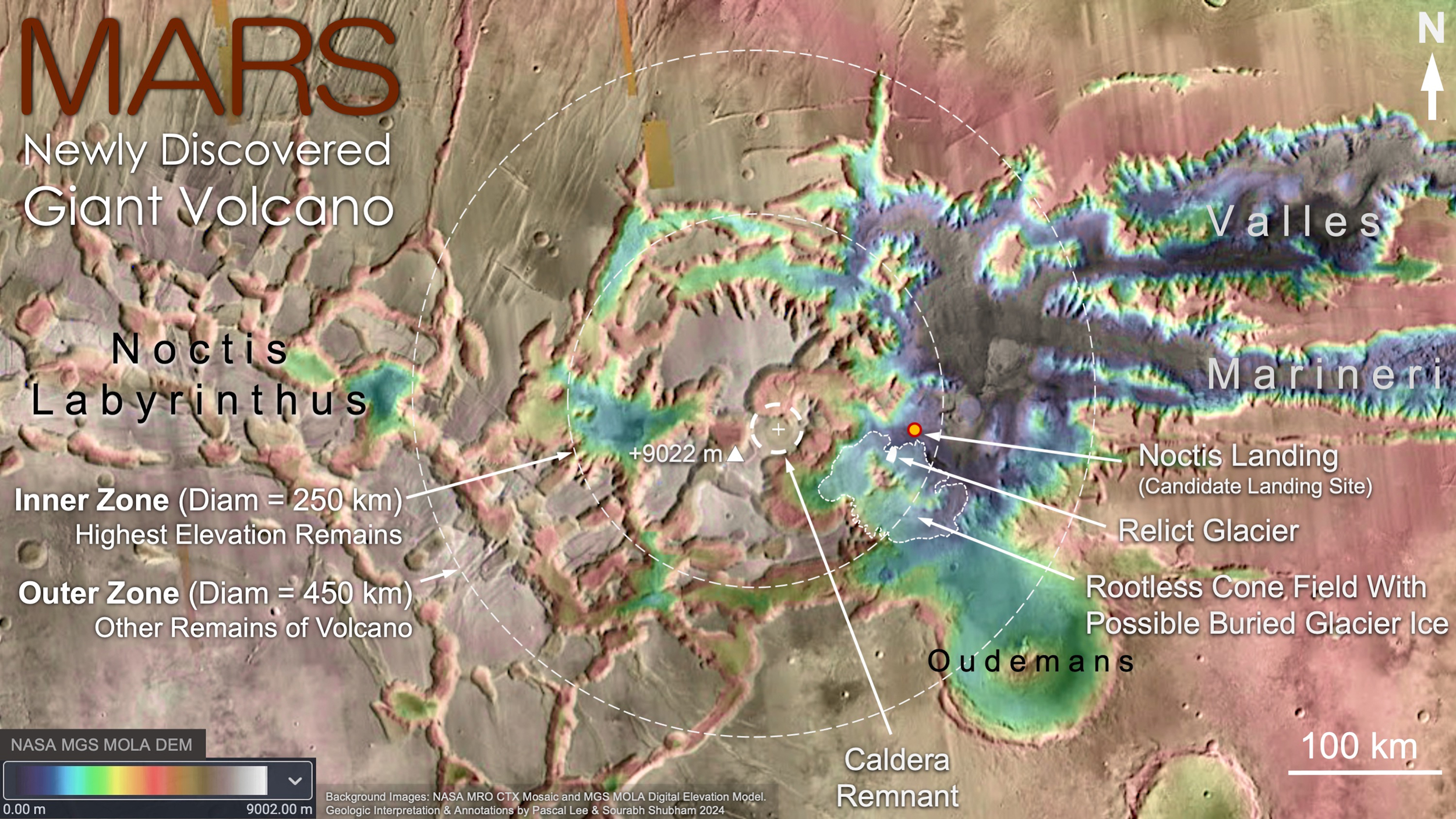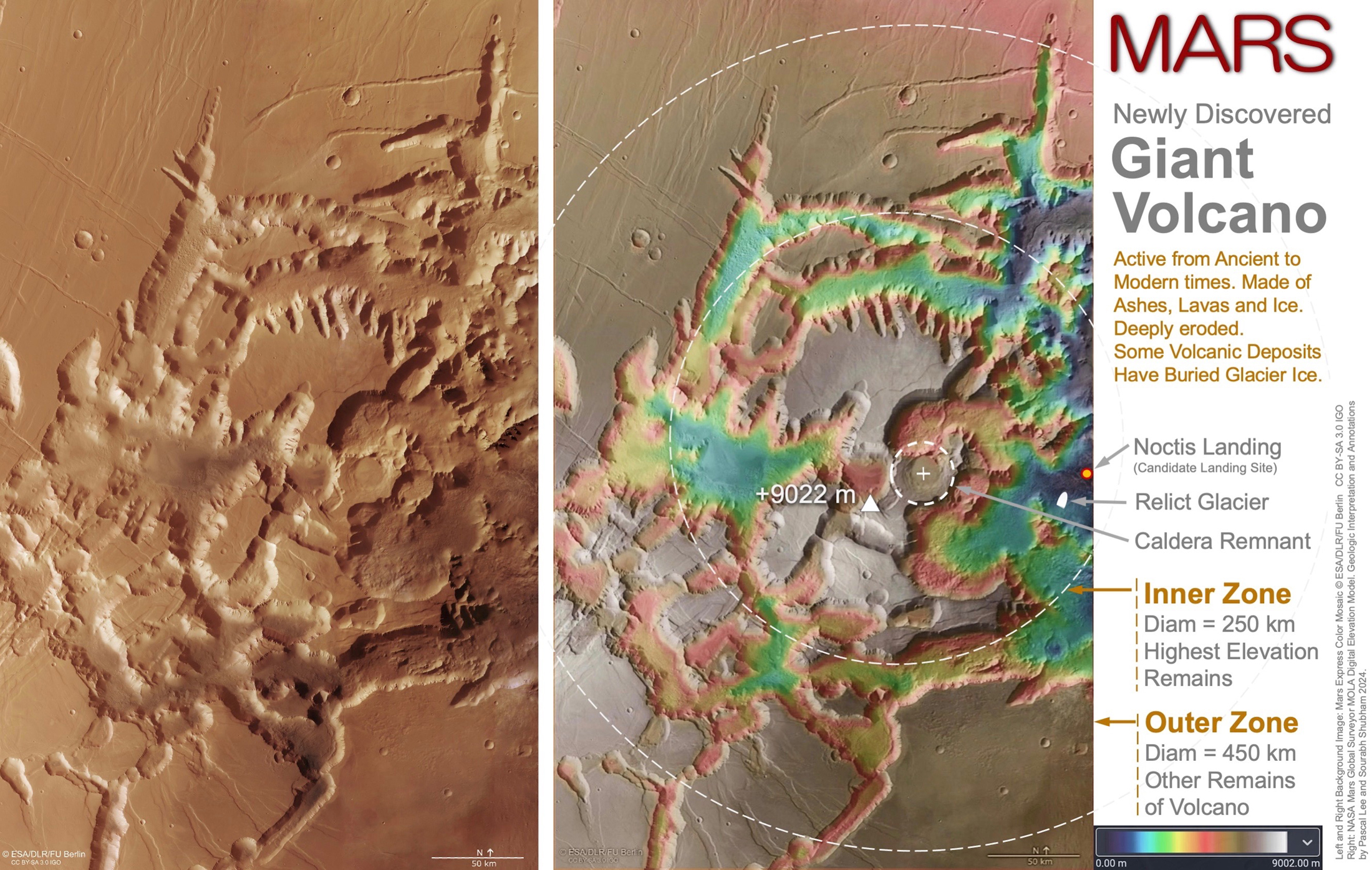A giant volcano taller than Mount Everest has been detected on Mars – but perhaps the most extraordinary thing is that it was sitting right there in images collected by Mariner 9 in 1972. A sheet of glacier ice is suspected of lying beneath it, and the likely combination of water and heat mean that if Mars does have life, this is one of the most likely places to find it.
When Mariner 9 reached Mars in November 1971, it marked the first time a spacecraft had successfully orbited another planet. Besides being a considerable win for America in the space race (two Russian vehicles were launched before it, but arrived after) it revealed the planets’ giant volcanoes. It turns out, however, that there was one more volcano in the images that no one noticed, and we’ve been overlooking it ever since – until now.
Martian volcanoes are big but not numerous, making each new discovery significant. The Tharsis volcanic province is made up of a giant bulge, the most prominent geographic feature on Mars, with three giant former volcanoes atop it. Just to the west of Tharsis lies Olympus Mons, which peaks 21.9 kilometers (14 miles) above the surrounding lands and is the size of Poland, making it the largest single volcano found anywhere.
The new discovery, carrying the provisional name “Noctis volcano”, is on the eastern side of the Tharsis province. Its peak is 9,028 meters (29,619 feet) above the surrounding sands, so it’s no match for Olympus Mons, but it’s still the seventh-highest spot on the planet. At 450 kilometers (280 miles) wide it’s three times wider than the island of Hawai’i.
Despite this, and a location less than 8 degrees south of the Martian equator, Noctis was not noticed because its collapsed shape doesn’t look like other volcanoes. Indeed, its discovery was rather accidental.

Noctis Volcano with a labyrinth of the same name to the west and the mighty Valles Marineris to the east
Image Credit: Background images: NASA Mars Reconnaissance Orbiter (MRO) Context Camera (CTX) mosaic and Mars Global Surveyor (MGS) Mars Orbiter Laser Altimeter (MOLA) digital elevation model. Geologic interpretation & annotations by Pascal Lee & Sourabh Shubham 2024).
“We were examining the geology of an area where we had found the remains of a glacier last year when we realized we were inside a huge and deeply eroded volcano,” Dr Pascal Lee of the SETI Institute said in a statement. Lee and University of Maryland graduate student Sourabh Shubham used images taken by seven orbiter missions, from Mariner 9 to those still operating today, to make and confirm the discovery.
Some of the Martian shield volcanoes have a classic cone shape almost worthy of Mt Fuji, but Noctis is a jumble of mesas and canyons surrounded by a gentle outer slope, hiding its nature, At the center is a collapsed volcanic crater – and once Lee and Shubham looked closely, they could see lava flows and deposits of ash and pumice covering a combined area of 5,000 square kilometers (1,930 square miles).
“This area of Mars is known to have a wide variety of hydrated minerals spanning a long stretch of Martian history. A volcanic setting for these minerals had long been suspected,” Shubham said. “So it may not be too surprising to find a volcano here. In some sense, this large volcano is a long-sought ‘smoking gun’.”
The glacier is topped by a sulfate deposit formed when volcanic materials reacted with the ice, prompting the pair to go looking for the source of the materials. Lee and Shubham suspect the glacier they have found may be just the edge of a vast sheet of ice, some buried just 1-3 meters (3-10 feet) deep.

High-resolution imaging of Noctis Volcano compared with altimetry revealing the height of its parts above the Martian background
Image Credit: Left: Mars Express HRSC color mosaic © ESA/DLR/FU Berlin CC BY-SA 3.0 IGO; Right: Background image: same as Left; NASA MGS MOLA digital elevation model. Geologic interpretation and annotations by Pascal Lee and Sourabh Shubham 2024).
Martian volcanoes are so big not only because they have less gravity to overcome, but because they do not suffer anything like the amount of erosion that equivalent structures would experience on Earth. However, Noctis has been exposed to more erosion than its counterparts as the heat from rising lava and the cold from the ice interacted to cause fracturing and catastrophic collapses.
Being so much more eroded than its counterparts leads to an easy assumption that Noctis must be far older than Olympus Mons or the other Thasis volcanoes. However, while its origins are probably very ancient, there are signs of relatively recent activity – and the discoverers are not ruling out the possibility it could erupt again.
As a site with definite water, and quite likely remnant pockets of heat, Noctis may be one of the best hopes to find life on Mars.
The discovery of the Martian volcanoes was a dramatic moment in the exploration of the solar system. Mariner 9 and the Russian probes Mars 2 and Mars 3 all arrived during a planet-wide dust storm, and at first, almost no surface detail could be seen. As the dust settled, the enormous volcanoes – the solar system’s largest – were the first features to emerge, offering a hint of how rich Mars is geologically.
Noctis volcano sits near the starting point of the Valles Mariners, a 4,000-kilometer (2,485-mile) long canyon that could Arizona’s version whole and barely notice. As such, it was already on a list of places NASA was keen to send a rover. That priority just went up.
Indeed, when it comes to human landing sites, a spot with ready access to (frozen) water near the equator ticks some of the most important boxes.
The discovery was presented at the 55th Lunar and Planetary Science Conference with an accompanying paper available online.
Source Link: We’ve Been Overlooking A Giant Martian Volcano For 50 Years